- From: Fletcher, Tony <Tony.Fletcher@choreology.com>
- Date: Tue, 18 Mar 2003 17:44:46 -0000
- To: <public-ws-chor@w3.org>
- Message-ID: <221369570DEDF346AE42821041345E890E6BBF@exchange1.corp.choreology.com>
Dear Colleagues, Just would like to make again in a message one of the points that I made at the inaugural W3C WS-Choreography group meeting, which I think was accepted. One discussion at the meeting centred on the scope of the work of this group and was phrased in terms of two possible scopes, one 'internal' and the other 'external'. I suggest that there are actually three different scopes we should consider, rather than just two. They are illustrated in the the attached (lightweight!) diagram. Scope 1 - might be called 'global' or some such Is the whole picture. Specifies the roles in the overall business process (buyer, distributor and supplier in this example) and the message sequences between each leg relative to other legs. It is relatively course grained. It seems to me that this kind of model is useful at design time - and only at design time. It allows one to design the overall process that achieves a particular business goal (/set of requirements). It allows one to decide which roles are required and what information needs to be exchanged between the roles. Scope 2 - bilateral Focuses in on a single bilateral relationship, such as buyer to distributor in the attached example and specifies the allowed message sequences, message meanings and the externally observable effects (such as some piece of information must be persisted at a specified point in time onwards). It is not concerned with the internal operation of either role. Thus in this case the buyer would just deal with the distributor and would not be concerned with the suppliers that the distributor uses - or even that there are suppliers rather than stuff being sourced internally. Obviously this does not mean that there are not other roles involved, just that they are not of concern to the bilateral relationship being focused on. This kind of model is essential for specifying interoperability between two roles. Scope 3 - internal This scope is concerned with the relationship between input and output 'ports' at a particular role and some of the details of processing. So in the example if we take the distributor then the internal scope is represented by the pink oval and concerns the messages received from and sent to the buyer and the various suppliers. It can include as much detail of the processing of messages and internal actions and events as is desired for a particular application of the language. This kind of model could actually be in the form of a language that is directly executable, or it could be in a form that provides configuration information to an execution engine. My intent is to clarify the possible scopes of any specification coming out of this WS-Choreography group, rather than to express an opinion on which we should adopt / focus on at this stage. Though I would agree with at least some others that it can be argued that Scope 2 is the most important as this is what needs to be shared and agreed between two role players. Best Regards, Tony <http://www.choreology.com/> Tony Fletcher Technical Advisor Choreology Ltd. 13, Austin Friars, London EC2N 2JX UK Phone: +44 (0) 20 7670 1787 Mobile: +44 (0) 7801 948 219 Fax: +44 (0) 20 7670 1785 Web: <http://www.choreology.com/> www.choreology.com Cohesions 1.0(tm) Business transaction management software for application coordination Work: tony.fletcher@choreology.com Home: amfletcher@iee.org
Attachments
- image/gif attachment: image002.gif

- image/jpeg attachment: 3_scopes.jpg

- application/vnd.ms-powerpoint attachment: 3 scopes.ppt
Received on Tuesday, 18 March 2003 12:44:53 UTC